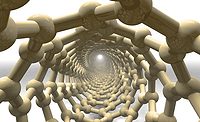Self-Crosslinking Polymer Technology for Longer-Lasting and Vibrant Colors

Although self-crosslinking polymer technology has been around for a while, manufacturers are just now figuring out how best to take advantage of its properties in their products. Mike Moore, AmCoat’s Director of Products and Applications, said the company uses the technology to improve its Rhino Shield formula.
“Self-crosslinking first came onto my radar about 10 years ago and I was very interested in it as a way to improve our Rhino Shield formula,” said Moore. “So, about 8 years ago we began testing the technology with our products, and 3 years ago we started a full-time effort to formulate and integrate self-crosslinking technology into our exterior formulas. It’s improved our top coats across the board.”
Self-crosslinking is a technology where two different polymer chains are linked through a chemical reaction. It’s important because you can use a single component product where the crosslinking is photo initiated. In other words, it goes to work automatically when exposed to UV light.
“While self-crosslinking is not unique to Rhino Shield, we were an early adopter of the technology and did a tremendous job vetting the science for coatings,” said Moore. “When the coating is exposed to light, the polymer chains start to join and form the paint film, there’s no other catalyst needed.”
Crosslinking improves coating colorfastness, durability and salt tolerance while maintaining flexibility. And the network of chains provides for superior wind-driven rain resistance. More and more coating manufacturers are seeing the benefits of the technology.
“The most durable and best coatings tend to use self-crosslinking technology,” said Moore. “By taking advantage of the technology, we’re getting more durability in our coatings, and it’s helping with our wind-driven rain tests and long-term colorfastness. This is super important in a single component coating and it is key to the high customer satisfaction Rhino Shield maintains.”
AmCoat’s President and CEO, Terence Andre, said researching new technology is a priority for the company.
“AmCoat has invested heavily in R&D so we can stay ahead of the curve and continue to create products our customers love,” said Andre. “It’s part of our commitment to exploring the latest technology and seeing if we can put it to work for our customers. Our customers benefit by getting a product with improved adhesion, elongation, tensile strength and permeability, all of which make up a long-term, high performing architectural wall coating.”
Looking for a reprint of this article?
From high-res PDFs to custom plaques, order your copy today!






